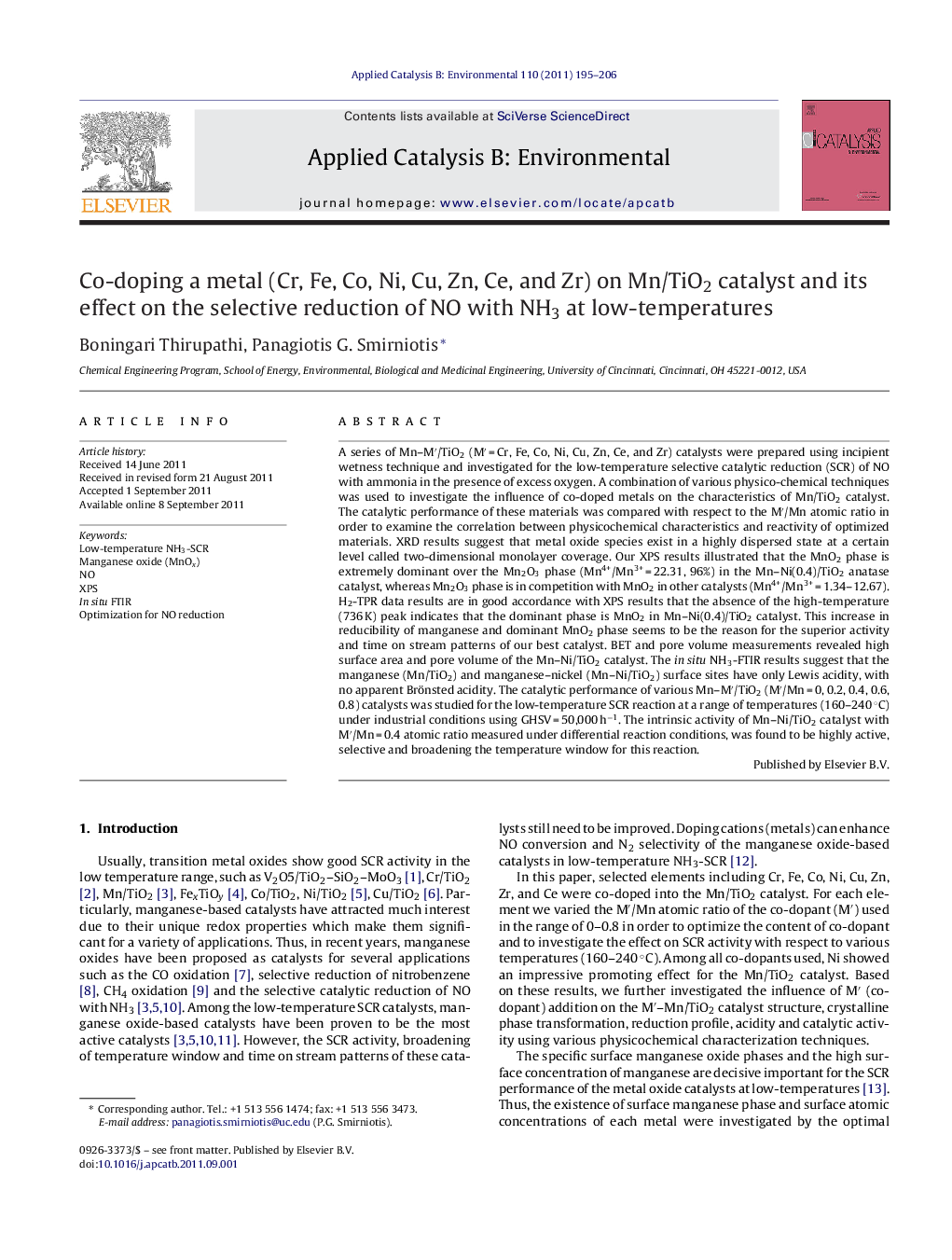| کد مقاله | کد نشریه | سال انتشار | مقاله انگلیسی | نسخه تمام متن |
|---|---|---|---|---|
| 46590 | 46442 | 2011 | 12 صفحه PDF | دانلود رایگان |

A series of Mn–M′/TiO2 (M′ = Cr, Fe, Co, Ni, Cu, Zn, Ce, and Zr) catalysts were prepared using incipient wetness technique and investigated for the low-temperature selective catalytic reduction (SCR) of NO with ammonia in the presence of excess oxygen. A combination of various physico-chemical techniques was used to investigate the influence of co-doped metals on the characteristics of Mn/TiO2 catalyst. The catalytic performance of these materials was compared with respect to the M′/Mn atomic ratio in order to examine the correlation between physicochemical characteristics and reactivity of optimized materials. XRD results suggest that metal oxide species exist in a highly dispersed state at a certain level called two-dimensional monolayer coverage. Our XPS results illustrated that the MnO2 phase is extremely dominant over the Mn2O3 phase (Mn4+/Mn3+ = 22.31, 96%) in the Mn–Ni(0.4)/TiO2 anatase catalyst, whereas Mn2O3 phase is in competition with MnO2 in other catalysts (Mn4+/Mn3+ = 1.34–12.67). H2-TPR data results are in good accordance with XPS results that the absence of the high-temperature (736 K) peak indicates that the dominant phase is MnO2 in Mn–Ni(0.4)/TiO2 catalyst. This increase in reducibility of manganese and dominant MnO2 phase seems to be the reason for the superior activity and time on stream patterns of our best catalyst. BET and pore volume measurements revealed high surface area and pore volume of the Mn–Ni/TiO2 catalyst. The in situ NH3-FTIR results suggest that the manganese (Mn/TiO2) and manganese–nickel (Mn–Ni/TiO2) surface sites have only Lewis acidity, with no apparent Brönsted acidity. The catalytic performance of various Mn–M′/TiO2 (M′/Mn = 0, 0.2, 0.4, 0.6, 0.8) catalysts was studied for the low-temperature SCR reaction at a range of temperatures (160–240 °C) under industrial conditions using GHSV = 50,000 h−1. The intrinsic activity of Mn–Ni/TiO2 catalyst with M′/Mn = 0.4 atomic ratio measured under differential reaction conditions, was found to be highly active, selective and broadening the temperature window for this reaction.
Effect of co-doped metals in Mn–M′/TiO2 catalysts investigated for the selective reduction of NO with NH3 at low temperatures and in presence of excess oxygen. XPS results illustrated that the MnO2 phase is extremely dominant over the Mn2O3 phase (Mn4+/Mn3+ = 96%) in the Mn–Ni(0.4)/TiO2 catalyst. The SCR activity, broadening of temperature window and steady time on stream patterns of the Mn/TiO2 catalyst are improved greatly by the addition of nickel.Figure optionsDownload as PowerPoint slideHighlights
► Ni (Ni/Mn = 0.4) increases the concentration of surface Mn4+ sites in Mn/TiO2 catalyst.
► Co-doping of Mn/TiO2 with Ni enables 100% NO conversion and N2 selectivity.
► MnO2 is the dominant phase in Mn–Ni(0.4)/TiO2 catalyst.
► Co-doping Mn/TiO2 with Ni broadens temperature window and catalyst stability.
► Mn–Ni/TiO2 surface sites have only Lewis acidity, with no Brönsted acidity.
Journal: Applied Catalysis B: Environmental - Volume 110, 2 November 2011, Pages 195–206